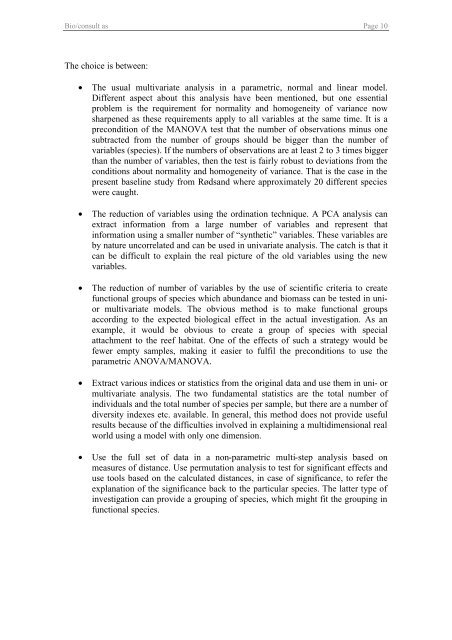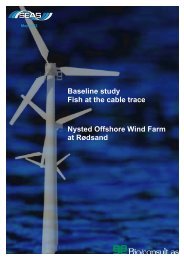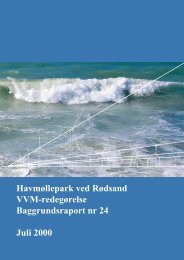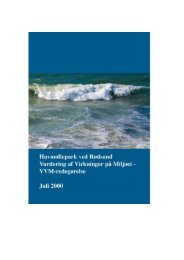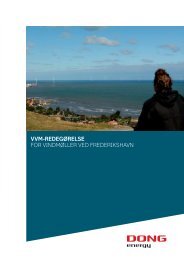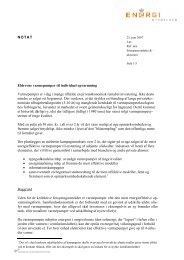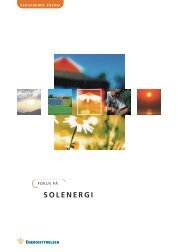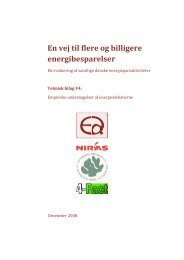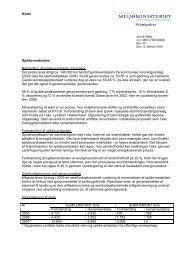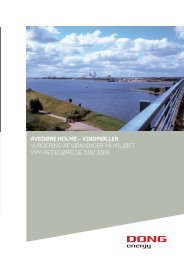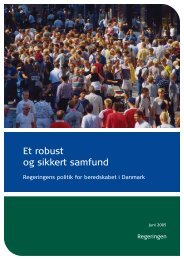Baseline study Fish, fry and commercial fishery Nysted Offshore ...
Baseline study Fish, fry and commercial fishery Nysted Offshore ...
Baseline study Fish, fry and commercial fishery Nysted Offshore ...
Create successful ePaper yourself
Turn your PDF publications into a flip-book with our unique Google optimized e-Paper software.
Bio/consult as Page 10<br />
The choice is between:<br />
• The usual multivariate analysis in a parametric, normal <strong>and</strong> linear model.<br />
Different aspect about this analysis have been mentioned, but one essential<br />
problem is the requirement for normality <strong>and</strong> homogeneity of variance now<br />
sharpened as these requirements apply to all variables at the same time. It is a<br />
precondition of the MANOVA test that the number of observations minus one<br />
subtracted from the number of groups should be bigger than the number of<br />
variables (species). If the numbers of observations are at least 2 to 3 times bigger<br />
than the number of variables, then the test is fairly robust to deviations from the<br />
conditions about normality <strong>and</strong> homogeneity of variance. That is the case in the<br />
present baseline <strong>study</strong> from Røds<strong>and</strong> where approximately 20 different species<br />
were caught.<br />
• The reduction of variables using the ordination technique. A PCA analysis can<br />
extract information from a large number of variables <strong>and</strong> represent that<br />
information using a smaller number of “synthetic” variables. These variables are<br />
by nature uncorrelated <strong>and</strong> can be used in univariate analysis. The catch is that it<br />
can be difficult to explain the real picture of the old variables using the new<br />
variables.<br />
• The reduction of number of variables by the use of scientific criteria to create<br />
functional groups of species which abundance <strong>and</strong> biomass can be tested in uni-<br />
or multivariate models. The obvious method is to make functional groups<br />
according to the expected biological effect in the actual investigation. As an<br />
example, it would be obvious to create a group of species with special<br />
attachment to the reef habitat. One of the effects of such a strategy would be<br />
fewer empty samples, making it easier to fulfil the preconditions to use the<br />
parametric ANOVA/MANOVA.<br />
• Extract various indices or statistics from the original data <strong>and</strong> use them in uni- or<br />
multivariate analysis. The two fundamental statistics are the total number of<br />
individuals <strong>and</strong> the total number of species per sample, but there are a number of<br />
diversity indexes etc. available. In general, this method does not provide useful<br />
results because of the difficulties involved in explaining a multidimensional real<br />
world using a model with only one dimension.<br />
• Use the full set of data in a non-parametric multi-step analysis based on<br />
measures of distance. Use permutation analysis to test for significant effects <strong>and</strong><br />
use tools based on the calculated distances, in case of significance, to refer the<br />
explanation of the significance back to the particular species. The latter type of<br />
investigation can provide a grouping of species, which might fit the grouping in<br />
functional species.


